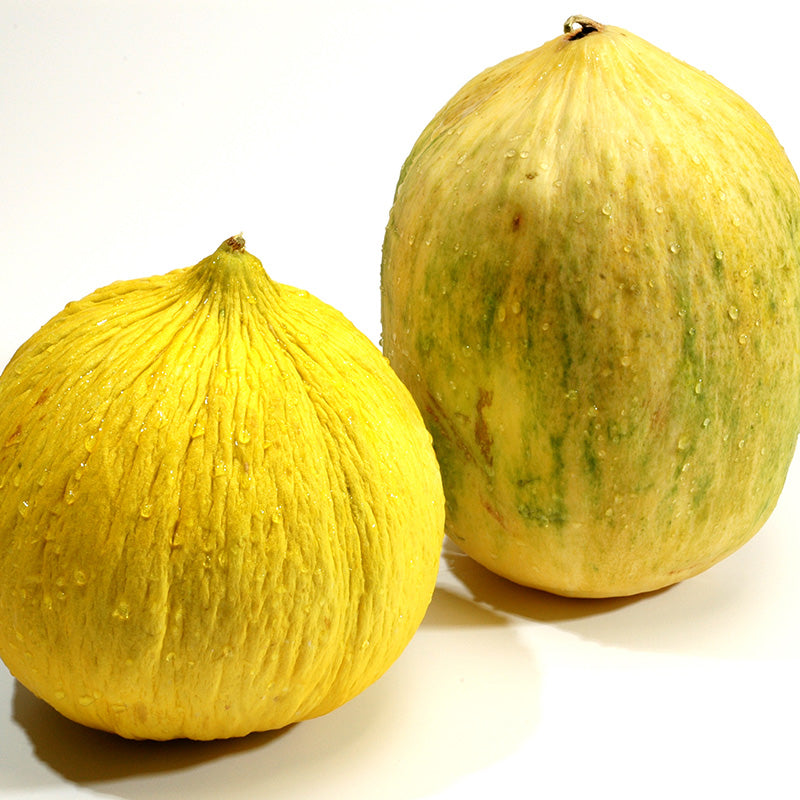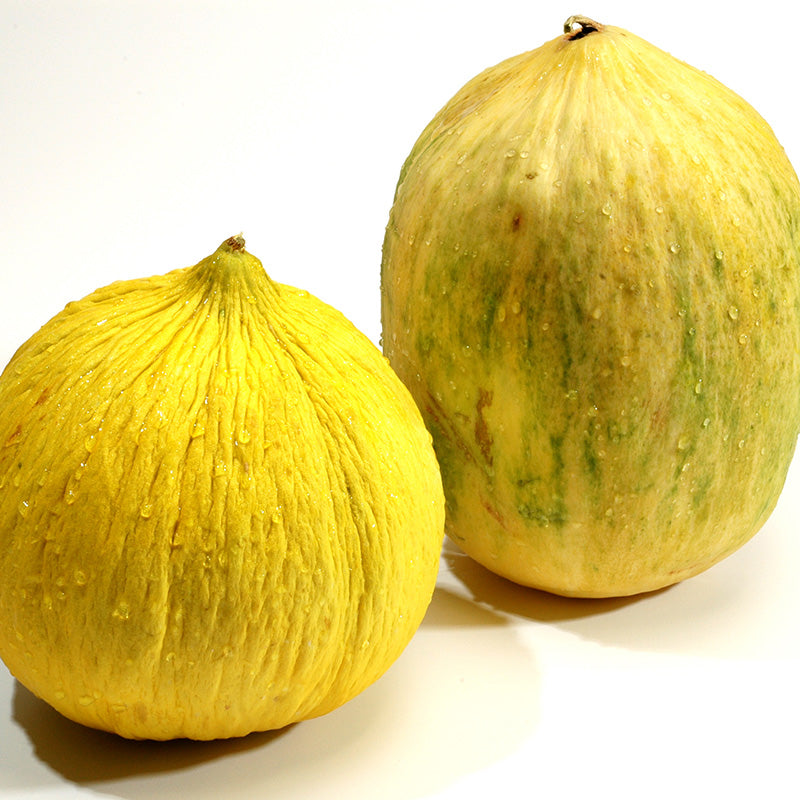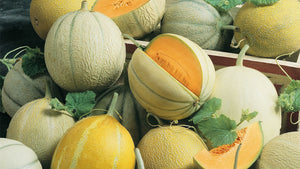Item Number: PV143
Organic Crenshaw Melon
Organic Crenshaw Melon
Melon Alchemy: Persian + Casaba
Crenshaw Melon (Cucumis melo) is a tender annual heirloom known for its oblong fruit with reddish-orange, sweet, and spicy flesh. Thriving in Southern California's coastal heat, these vigorous vines stem from a cross between Persian and Casaba melons.
Sustainably grown in 2.75" pots
Preparing the Soil
Crenshaw melons thrive in well-drained, sandy loam soil with a pH level between 6.0 and 7.0. Before planting, prepare the soil by amending it with organic matter such as compost or aged manure to improve its texture and fertility. Remove any weeds and debris from the planting area to create a clean and healthy growing environment for your Crenshaw melons.
Planting Crenshaw Melons
Crenshaw melons are warm-season crops that require plenty of sunlight to thrive. Plant starts in late spring or early summer, once the soil has warmed up to at least 70°F (21°C). Space plants 2 to 3 feet apart in rows spaced 4 to 6 feet apart to allow for adequate air circulation and room for vine growth.
Watering and Care
Crenshaw melons require consistent moisture throughout the growing season, especially during hot, dry weather. Water the plants deeply once or twice a week, providing enough water to keep the soil evenly moist but not waterlogged. Avoid overhead watering, as wet foliage can promote fungal diseases. Mulching around the base of the plants can help retain soil moisture and suppress weeds.
Fertilizing
Crenshaw melons are heavy feeders and benefit from regular fertilization throughout the growing season. Apply a balanced fertilizer or compost tea every 3 to 4 weeks to provide essential nutrients for healthy growth and fruit development. Be sure to follow the manufacturer's instructions for application rates and timing.
Training and Support
Crenshaw melons are vining plants that benefit from support and training to keep the fruit off the ground and prevent rotting. Consider using trellises, cages, or stakes to support the vines and encourage upward growth. Prune the vines as needed to remove any dead or diseased foliage and promote air circulation around the plants.
Pest and Disease Management
Crenshaw melons are susceptible to a variety of pests and diseases, including aphids, cucumber beetles, powdery mildew, and bacterial wilt. Monitor your plants regularly for signs of pest infestations or disease symptoms and take appropriate action to control them. Use insecticidal soap or neem oil to treat aphids and cucumber beetles, and apply fungicides to prevent powdery mildew.
Harvesting Crenshaw Melons
Crenshaw melons are ready to harvest when they develop a golden yellow color and a sweet aroma. The blossom end of the melon should yield slightly to pressure when gently pressed. Use a sharp knife to cut the fruit from the vine, leaving a short stem attached. Crenshaw melons can be stored at room temperature for a few days or refrigerated for longer storage.
Growing Crenshaw melons can be a rewarding experience that allows you to enjoy delicious, homegrown melons right from your garden. By following the tips and guidelines outlined in this guide, you can successfully cultivate Crenshaw melons and enjoy a bountiful harvest of sweet and flavorful fruits all summer long.





Check Your Zone Compatibility:
Compatible with your zone.
Growing Zone for
,

Our Guarantee To You
Since 1976, we've served our customers at every stage of growing. Please contact us at any time. We are happy to support and assist you.
Description
Description
Crenshaw Melon (Cucumis melo) is a tender annual heirloom known for its oblong fruit with reddish-orange, sweet, and spicy flesh. Thriving in Southern California's coastal heat, these vigorous vines stem from a cross between Persian and Casaba melons.
Sustainably grown in 2.75" pots
Preparing the Soil
Crenshaw melons thrive in well-drained, sandy loam soil with a pH level between 6.0 and 7.0. Before planting, prepare the soil by amending it with organic matter such as compost or aged manure to improve its texture and fertility. Remove any weeds and debris from the planting area to create a clean and healthy growing environment for your Crenshaw melons.
Planting Crenshaw Melons
Crenshaw melons are warm-season crops that require plenty of sunlight to thrive. Plant starts in late spring or early summer, once the soil has warmed up to at least 70°F (21°C). Space plants 2 to 3 feet apart in rows spaced 4 to 6 feet apart to allow for adequate air circulation and room for vine growth.
Watering and Care
Crenshaw melons require consistent moisture throughout the growing season, especially during hot, dry weather. Water the plants deeply once or twice a week, providing enough water to keep the soil evenly moist but not waterlogged. Avoid overhead watering, as wet foliage can promote fungal diseases. Mulching around the base of the plants can help retain soil moisture and suppress weeds.
Fertilizing
Crenshaw melons are heavy feeders and benefit from regular fertilization throughout the growing season. Apply a balanced fertilizer or compost tea every 3 to 4 weeks to provide essential nutrients for healthy growth and fruit development. Be sure to follow the manufacturer's instructions for application rates and timing.
Training and Support
Crenshaw melons are vining plants that benefit from support and training to keep the fruit off the ground and prevent rotting. Consider using trellises, cages, or stakes to support the vines and encourage upward growth. Prune the vines as needed to remove any dead or diseased foliage and promote air circulation around the plants.
Pest and Disease Management
Crenshaw melons are susceptible to a variety of pests and diseases, including aphids, cucumber beetles, powdery mildew, and bacterial wilt. Monitor your plants regularly for signs of pest infestations or disease symptoms and take appropriate action to control them. Use insecticidal soap or neem oil to treat aphids and cucumber beetles, and apply fungicides to prevent powdery mildew.
Harvesting Crenshaw Melons
Crenshaw melons are ready to harvest when they develop a golden yellow color and a sweet aroma. The blossom end of the melon should yield slightly to pressure when gently pressed. Use a sharp knife to cut the fruit from the vine, leaving a short stem attached. Crenshaw melons can be stored at room temperature for a few days or refrigerated for longer storage.
Growing Crenshaw melons can be a rewarding experience that allows you to enjoy delicious, homegrown melons right from your garden. By following the tips and guidelines outlined in this guide, you can successfully cultivate Crenshaw melons and enjoy a bountiful harvest of sweet and flavorful fruits all summer long.
Shipping Information
Shipping Information
Cannot ship to the following states: AK, HI, PR, VI, GU
Shipping Weight: 0.5 lb
Dimensions: 6.0"L x 2.75"W x 2.75"H
Features
Features
- Heirloom
- Open-Pollinated
Characteristics
Characteristics
Planting & Care
Planting & Care
Soil & Water: Melons like moderately rich, well-drained soils with plenty of phosphorous and potassium and a pH of 6.0-6.8. For flavorful fruits, melons need moderate water during growth, and low, even water during fruit development.
Planting & Growing: Plant starts in late spring or early summer, once the soil has warmed up to at least 70°F (21°C). Space plants 2 to 3 feet apart in rows spaced 4 to 6 feet apart to allow for adequate air circulation and room for vine growth.
Harvesting & Storage: Melons are ripe when the rind changes color to yellow and gentle pressure separates the stem from the vine. Melons can be stored in the refrigerator for about a week.
Useful Information
Useful Information
Guarantee
Guarantee
We guarantee the perishable items we sell to be in good, viable condition when we sell them. Perishable items include, but are not limited to, garlic bulbs, flower bulbs, seed potatoes, onion sets & transplants, potted or bare root trees, vegetable crowns, etc. If your perishable item arrives in substandard condition, take photographs and please contact us within 3 days of the purchase date (or delivery date) and we will provide you with a refund of the purchase price (excluding shipping costs), or a replacement. Accordingly, we urge you to open any boxes marked as ""Perishable"" immediately upon receiving them and inspect the shipment thoroughly (do not crack open heads of garlic, we do not accept claims on cracked garlic). Because some perishable items can deteriorate very quickly, we cannot accept any claims beyond the 3-day time frame as it becomes too difficult to determine if these items were delivered in substandard condition, or if they turned into such substandard condition because of having been improperly cared for or stored once delivered.
Share



